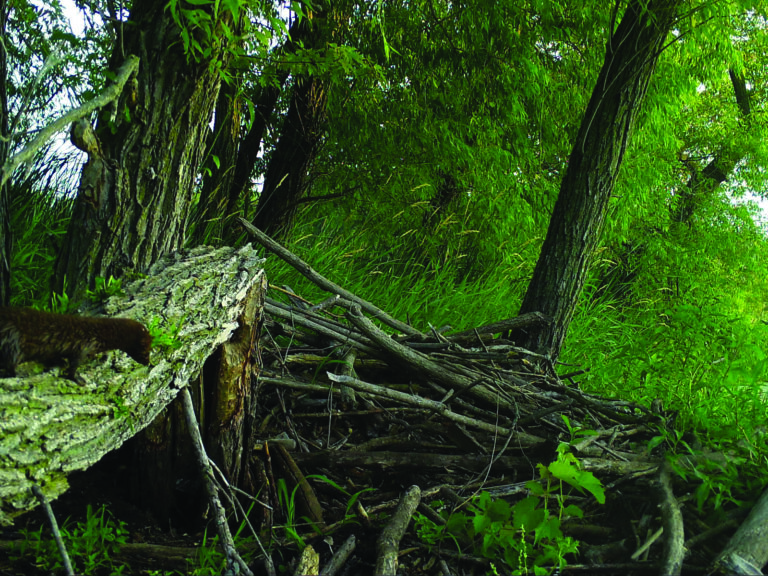
By members of Wild Warner

Paul Noeldner has long been an advocate for resident beavers in Warner Lagoon. “Beavers help create more diverse ecosystems,” he noted. Not only do branches dropped into the water create shelter for small fish and young turtles, the beavers control shoreline poplar and willow populations. In the absence of dense growth along the shore, other plant species thrive, and many animals can take advantage of the various shore conditions as well. “Beavers are one of our keystone species,” said Noeldner. “When we see bald eagles, sandhill cranes and beavers, that’s an indicator that all sorts of other good things are going on in the park. While a degraded habitat would support a solitary beaver, the fact that the current resident beavers have had pups two years running is a sign of a strong, healthy food web. And they’re cute.”
In the past, however, “cute” wasn’t enough to prove to the Madison’s City Engineering Department that the benefit of beavers outweighs the potential costs. In 2016, a solidly-built dam across the outflow between Lake Mendota and Warner Pond caused flooding issues, and shortly after the dam was removed, so were the beavers.
In May 2017, Wild Warner coordinated with the city to hold a public meeting about the issue at the Warner Park Community Recreation Center, where then-Assistant Supervisor of City Parks Charlie Romines explained the rationale behind beaver removal. Taking public input into account, the city decided to take a hands-off approach unless beavers cause critical infrastructure blockages that can’t be ignored.

Higher water levels in the past few years mean Warner Park’s current beaver family doesn’t need to build a dam. A beaver pond must be deep enough to allow beavers to swim to and from their winter food-stores even when the water is capped with a foot of ice. If they’re forced out into the world above, they risk not only subzero temperatures, but predators such as coyotes, bobcats and wolves. Yearling beavers can easily fall prey to smaller predators such as foxes, birds of prey and even omnivorous raccoons.
Aside from dam construction, the main obstacle to peaceful coexistence is the loss of trees. Of particular concern are native trees, some of which are long lived and slow growing, trees, including river and paper birch, oaks, hackberry, ironwood, maple, hawthorn, basswood, tamarack, honey locust, sycamore and Kentucky coffee tree.
Every time a new colony of beavers arrives in an area, their first task is to cut down a supply of large trees for building materials and food. In 2016, many large cottonwoods were felled in the Warner Dog Park and along the southwest edge of the lagoon. The beavers arriving in 2019 also took down a number of trees, which was concerning those who enjoy their shade and beauty. Fortunately, the destruction came to a halt in the spring of 2020 as the beavers turned their attention to smaller, more plentiful saplings.
In March, Wild Warner President Kathlean Wolf began discussing the future of trees and beavers with Madison Parks Division staff, looking for a long-term solution for coexistence. Mike Rewey, a member of Wild Warner, identified 61 trees around Warner Pond in greatest need of protection. Kristin Mathews, East Parks Supervisor, and Paul Quinlan, Conservation Supervisor, arranged to provide 400 feet of welded wire mesh to deter beavers. It was up to Wild Warner to provide the volunteers for the project. Then, COVID-19 changed everything.
“Wild Warner depends on community volunteers to help with projects that come up in the park,” said Volunteer Coordinator Marie Jacobson. “Due to the pandemic, the volunteer base dried up to literally nothing.”
Ironically, a side effect of COVID-19 was finding a solution to the volunteer problem. Wild Warner’s monthly meetings switched to online, reconnecting members for whom in-person meetings were difficult, including founding member Dolores Kester. It was Kester who suggested contacting her neighbor, Stedman Windsor-Engnell, an active member of his local scout troop. Jacobson, whose two sons are both Eagle Scouts, worked with scout leaders to organize the project.
On a rainy day in October, the scouts of Troops 127 and 7121 came together with volunteers from Wild Warner to fence off the marked trees. Twin sisters Lauren and Audrey Billings, sophomores at East High School and active scout members, explained to a reporter for the Wisconsin State Journal that the volunteer hours would count toward advancement in the scouting program. With this activity, Lauren will be able to complete her Citizenship in the Nation Badge. Audrey was quoted in WSJ, “I thought it would be a fun activity to do [to] get out of the house for today, and it’s always nice to get service hours.”
In the end, everyone walked away a winner. The scouts learned about this neighborhood park and helped keep the park filled with wildlife diversity. Wild Warner is excited about the prospect of forming partnerships with local scouting groups and is considering ways to create a “junior member” program.
Wild Warner is grateful to the Parks Division for contributing the supplies and are glad to find another way to honor and encourage the wild side of Warner Park. “Best of all,” said Jacobson, “the beavers have a chance to enjoy a safe place to live and prosper.”